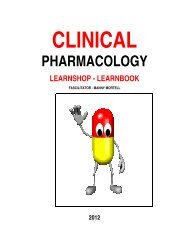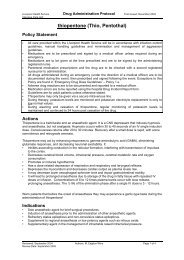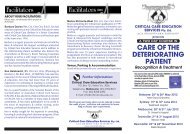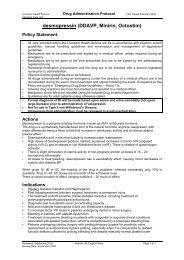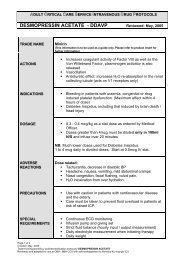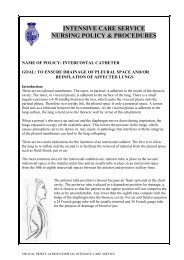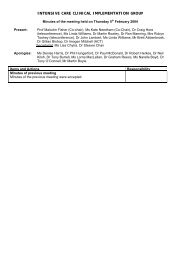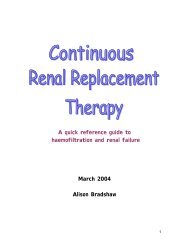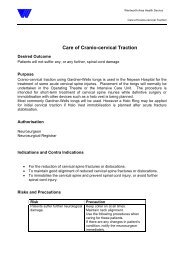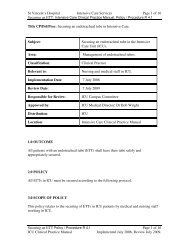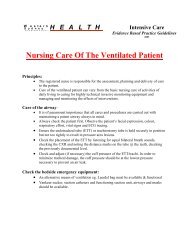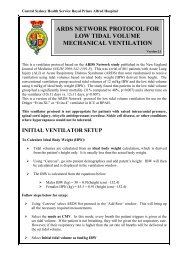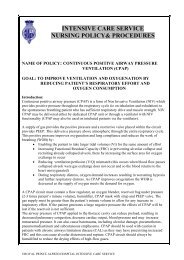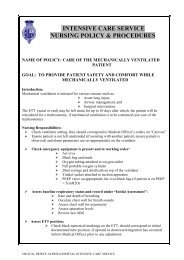Stabilisation of an Endotracheal Tube for the Adult Intensive Care ...
Stabilisation of an Endotracheal Tube for the Adult Intensive Care ...
Stabilisation of an Endotracheal Tube for the Adult Intensive Care ...
You also want an ePaper? Increase the reach of your titles
YUMPU automatically turns print PDFs into web optimized ePapers that Google loves.
The consequences <strong>of</strong> migration or movement <strong>of</strong> <strong>an</strong> ETT within a patient’s airway c<strong>an</strong> include<br />
patient discom<strong>for</strong>t <strong>an</strong>d pain, inadequate ventilation <strong>an</strong>d tracheal damage however no<br />
reference or research was found indicating a consensus regarding <strong>the</strong> accepted safe level <strong>of</strong><br />
ETT movement. ETT movement may be from side to side or ‘in <strong>an</strong>d out’ <strong>of</strong> <strong>the</strong> airway (<strong>of</strong>ten<br />
referred to as telescoping) <strong>an</strong>d movement in ei<strong>the</strong>r direction is a signific<strong>an</strong>t source <strong>of</strong><br />
discom<strong>for</strong>t <strong>for</strong> <strong>the</strong> patient <strong>an</strong>d may cause damage to <strong>the</strong> skin <strong>an</strong>d mucosal lining <strong>of</strong> <strong>the</strong><br />
trachea. The recommendation <strong>of</strong> 1cm maximum movement is based on consultation with<br />
intensive care medical specialists <strong>an</strong>d group consensus <strong>of</strong> GDN members. For this guideline<br />
<strong>an</strong> ETT that moves more th<strong>an</strong> 1cm is considered to be unstable <strong>an</strong>d <strong>the</strong> method should be<br />
renewed as soon as prioritised given o<strong>the</strong>r factors such as:<br />
1. The amount <strong>of</strong> ETT movement;<br />
2. Patient’s general condition especially respiratory <strong>an</strong>d cardiovascular status;<br />
3. Patient movement <strong>for</strong> procedures or tr<strong>an</strong>sport outside <strong>the</strong> ICU; <strong>an</strong>d<br />
4. O<strong>the</strong>r life saving procedures.<br />
Assessment <strong>of</strong> restrictiveness <strong>of</strong> ETT tapes or devices is open to interpretation. The<br />
recommendation to use one or two fingers is included in a number <strong>of</strong> CPGs sourced from<br />
across NSW ICU [see<br />
http://intensivecare.hsnet.nsw.gov.au/five/staffonly/guidelines_type_ventilation.php].<br />
During discussions a number <strong>of</strong> concerns were raised regarding this particular practice<br />
including <strong>the</strong> subjective nature <strong>of</strong> this measure, differences in patients’ facial skin integrity<br />
<strong>an</strong>d <strong>the</strong> potential <strong>for</strong> facial swelling. However although <strong>the</strong> recommendation is made to<br />
ensure two fingers c<strong>an</strong> be inserted between skin <strong>an</strong>d cotton tapes this should be applied<br />
with caution <strong>an</strong>d o<strong>the</strong>r recommendations taken into consideration.<br />
A daily CXR is a common investigation both to identify <strong>the</strong> development or resolution <strong>of</strong><br />
pathological lung ch<strong>an</strong>ges <strong>an</strong>d to check <strong>the</strong> position <strong>of</strong> <strong>the</strong> endotracheal <strong>an</strong>d nasogastric<br />
tube. The optimal position <strong>of</strong> <strong>the</strong> ETT measured fiberoptically is between 2.5–4 cm above<br />
<strong>the</strong> carina (Evron, Weisenberg et al. 2007). Migrations <strong>of</strong> <strong>the</strong> ETT fur<strong>the</strong>r down <strong>the</strong> trachea<br />
risks injury to <strong>the</strong> carina <strong>an</strong>d/or endobronchial intubation, a potentially catastrophic<br />
complication. Conversely if <strong>the</strong> ETT is not positioned far enough down <strong>the</strong> trachea <strong>the</strong>re are<br />
several risks including: vocal cord injury as <strong>the</strong> cuff impacts on <strong>the</strong> vocal cords; inadequate<br />
ventilation; patient agitation due to discom<strong>for</strong>t; <strong>an</strong>d unexpected extubation. There<strong>for</strong>e <strong>for</strong><br />
most patients <strong>the</strong> ETT position on CXR should be checked be<strong>for</strong>e <strong>the</strong> ETT stabilisation<br />
method is ch<strong>an</strong>ged to ensure <strong>the</strong> ETT is in <strong>the</strong> optimal position. It is also common practice<br />
15



